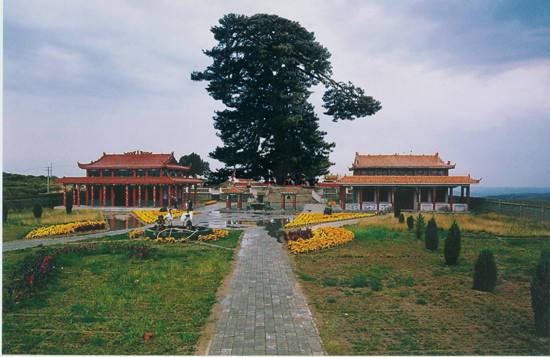
In the long history of Ordos, drastic environmental changes took place. Witnessing the great changes all alone, an old pine is standing here for a thousand years. This is the first pine of China — the king of southern Chinese pines in Jungar Banner.
Beyond countless mountains, at 1,400 meters above sea level, in Narisong county Jungar Banner, the old tree stands majestically on the ground with its lush foliage stretching like clouds. Sitting under the old pine, one can see the grey-brown limb approaching the sky, and snarled branches are twisting like dragons and the flat-topped crown blots out the sunshine. For hundreds of years, local people have been honoring the king of southern Chinese pines as sacred, beautifully expressed in the folksong “Jungar Banner has an old pine, people said a god is living inside.” How sacred on earth is this old pine? There are various legends. One is, that in the old times there were several fierce power struggles in the palace of the prince of Jungar. Whenever a prince was assassinated, a tree branch would break off from the old pine. Another version tells that a villager was dogged by misfortune shortly after he stripped a piece of bark from the old pine. In another, a villager who stole the offerings to the old pine was confined to the bed with a serious illness, he couldn’t restore health until he burned incense and prayed in front of the old pine. Although these stories are superstition, people were inspired and revered the old pine. Interestingly, this reverence protected the giant tree.
During the disastrous Cultural Revolution (1966-1976), some people wanted to cut down the old pine on the excuse of breaking the “four olds” (namely old ideas, old culture, old customs and old habits). Wang Sheng, the branch secretary of the village, came forward bravely and said “a pine is a pine, it has nothing to do with the ‘four olds’. If you want to hack the pine, hack me first!” Even until today, the story that Wang Sheng courageously protected the old pine is still known to everyone. Later on, someone intended to stealthily cut the tree. It was said that after the first blow of the axe, red resin ran out of the old pine. The hacker was so scared that the second blow was swung onto his thigh and the blood gushed from the wound immediately. Since then no one dared to cut down the old pine. Today there is still a deep scar left by an axe on a side branch, telling the sad stories of the past times. Not far from the old pine, there are three ancient cities of Earlier Song Dynasty (A.D. 960-1127), namely, Fengzhou, Baoning camp and Yong’an camp. There are more than thirty beacon towers of the Song Dynasty which were mistakenly treated as Aobao (means a pile of stones, earth, or grass in Mongolian) by the local people. All these ancient relics came into being alongside the old pine. Looking from the ancient relics of Yong’an camp, the old pine and the beacon towers are clearly distinguishable. Standing by the desolate ancient cities, the lush green old pine tree displays astonishing vigor. According to the historical documents, this place once suffered wars throughout the year because of its strategic location — the juncture of Earlier Song Dynasty, the Western Xia regime and the Liao Dynasty. How did the old pine survive the chaos? Perhaps all soldiers, no matter which regime they came from, believed that they must protect this sacred tree. During Ming Dynasty Tianshun period (A.D. 1457-1464), after the Ordos tribe resided in Hetao (the present Ordos), the people built temples beside the old pine tree. During Ming Dynasty Huacheng period (A.D. 1465-1487), a wandering Tibetan tulku (literally means living Buddha) saw this magnificent towering old pine and placed a golden Buddha in the tree hole and then guarded here day and night. Since then, more than twenty Lamas practiced meditation and chanted sutras under the old pine tree. Long been held with earnest respect and under protection by Tibetan Buddhism, the old pine tree has been endowed with mysterious and profound cultural heritage in relation to aromatic incense and sutra prayers. No wonder, it has become a sacred symbol in people’s mind. Though we need to abandon idealism, particularly ideas such as the illusory concept of “sacred” and praying, it remains a fact that people developed an even temperament and an optimistic spirit by revering the scared old pine. Beyond any doubt, the civilizing influence that the old pine bestowed upon its people has been profound.
In 1978, experts from Chinese Academy of Forestry conducted a general test of the old pine tree. The height was found 26 meters, DBH 1.34 meters and wood volume 13.5 cubic meters. From the core sample of a drilling test, scientists found that the “king of the southern Chinese pines” grew from a natural seed fall 930 years ago. In June 1997, experts from the Institute of Botany under the Chinese Academy of Science verified the test results of 1978 and found that the old pine tree rose to 27 meters, DBH boosted to 1.5 meters and wood volume increased to 14.5 cubic meters. After nearly one thousand years, the old pine tree still flourishes in great vigor.
The local government and the people have been making great efforts to protect the old pine tree. In 1996, the king of southern Chinese pines was included into the list of the third batch of major protection unit of cultural relics by the Government of Inner Mongolia Autonomous Region. In recent years, the People’s Government of Jungar Banner made a comprehensive arrangement to develop tourism industry in the area in order to protect the old pine tree. So far the total investment for 3.5 square kilometers of planning area is RMB 200 million, including 35,000 square meters of construction area and over 300,000 square meters of green area. Both the facilities and environment of the scenic spot will be improved to meet the standard of national 4A-level tourist attraction, as well as to greet 10,000 tourists each year. Li Cunshi, 64 years old deputy head of the management station of the scenic spot, has been working here for 16 years and has developed an emotional bond with the old pine. He has been devoted to study the history and culture of the old pine. Whenever professionals of the industry came to see the old pine, he would be eager to have an in-depth conversation with them. His ultimate dream is to write a monograph on the cultural history of the king of southern Chinese pines.
Inside the scenic spot, Songlin Temple, including Sanhuang Hall, Yaowang Hall and another seven halls, was rebuilt. As a permanent site for Buddhism activities in Ordos city, the old pine scenic spot is accompanied by aromatic incense and lamas’ prayer throughout the year. Every year on the 25th of the first month, 13th of the fifth month and 15th of the seventh month in lunar calendar, there are celebrations and fairs. In order to further develop the premises, residents of the two villages nearby the old pine have moved to a new village to make more room for the scenic spot. Among the local residents, 62 households run shops in the old pine tree scenic spot. Chen Qi, a local resident, got a first-floor room facing the street of over 300 square meters from the government. He earned more than RMB 70,000 last year by selling daily necessities, food and beverages. This 61 years old man is full of confidence in running businesses at the place. Protecting the local area for hundreds of years, the old pine tree still benefits people’s life. With 9.1 billion metric tons of coal reserves in Narisong County, Jungar Banner ranks first in terms of coal production among all counties in China. The old pine is located in Songshuyan village, Narisong County. Both of the places were named after the pine. “Narisong” is a Mongolian word meaning pine and “Songshu” are the exact two characters in Chinese standing for pine. In Narisong, there is still some intact primeval forest in the Aguimiao Vegetation Conservation Area. Almost 95% of the land is covered by pine trees varying in 60 pinaceae, 197 pinus and 324 pine species in the entire 1.07 square kilometers. Though Narisong is a major coal mining area with 59 mines in the county, it nevertheless protects the environment. In Songwang Temple, we found a special donation list on the wall. It records the number of trees planted each year along with the name of the people donating trees and the donations made by companies. The thousand years old pine tree motivates the awareness of protecting environment in local sensibility as the residents make donations and plant trees in response. Narisong country has developed a new trend of environment protection with people planting trees and companies making donations under the government’s leadership. In 2016 only, 130,000 saplings were planted by the community.
Standing firm for nearly a thousand years, the sacred old pine attracts numerous tourists nationwide and motivates the local residents to maintain the ecological balance. It is a tree of courage, perseverance, determination and strength, encouraging people in Ordos to rise to the challenge and strive for a better life with an unshakable resilience.











